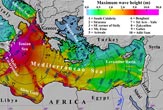
A volcano avalanche in Sicily 8,000 years ago triggered a devastating tsunami taller than a 10-story building that spread across the entire Mediterranean Sea, slamming into the shores of three continents in only a few hours [image].
A new computer simulation of the ancient event reveals for the first time the enormity of the catastrophe and its far-reaching effects [video].
The Mt. Etna avalanche sent 6 cubic miles of rock and sediment tumbling into the water—enough material to cover the entire island of Manhattan in a layer of debris thicker than the Empire State Building is tall.
The mountain of rubble crashed into the water at more than 200 mph. It pummeled the sea bed, transformed thick layers of soft marine sediment into jelly and triggered an underwater mudslide that flowed for hundreds of miles.
Recreating an ancient disaster
To create their computer simulation, researchers at the National Institute of Geophysics and Volcanology in Italy used sonar-equipped boats to survey seafloor sediment displaced by the Mt. Etna avalanche.
Their recreation suggests the tsunami's waves reached heights of up to 130 feet and maximum speeds of up to 450 mph, making it more powerful than the Indonesian tsunami that killed more than 180,000 people in 2004.
Sign up for the Live Science daily newsletter now
Get the world’s most fascinating discoveries delivered straight to your inbox.
The researchers have also linked the ancient tsunami with the mysterious abandonment of Atlit-Yam, a Neolithic village located along the coast of present-day Israel. When archeologists discovered the village about 20 years ago, they found evidence of a sudden evacuation, including a pile of fish that had been gutted and sorted but then left to rot.
"A tsunami was not suspected before," lead researcher Maria Pareschi told LiveScience.
Could happen today
According to Pareschi, if the same tsunami struck today, Southern Italy would be inundated within the first 15 minutes [image]. In one hour, the waves would reach Greece's western coasts. After an hour and a half, the city of Benghazi in Northern Africa would be hit. At the three and a half hour mark, the waves would have traversed the entire Mediterranean to reach the coasts of Israel, Lebanon and Syria.
Avalanches and minor eruptions still occur on Mt. Etna today, but so far, nothing approaching the magnitude of the ancient event.
"Should the Neolithic Etna tsunami have occurred today, the impact is tremendous because the Eastern Mediterranean coasts are very inhabited ones," Pereschi said.
- See the Simulation
- How Tsunamis Work
- Tsunami Special Report
- Image Gallery: Asian Tsunami Disaster
- The Megatsunami: Possible Modern Threat
- ImageGallery: Monster Waves
- Global Disaster Hotspots
- The Odds of Dying









